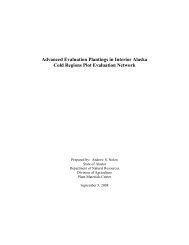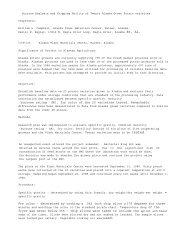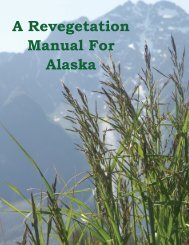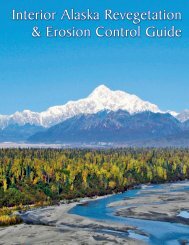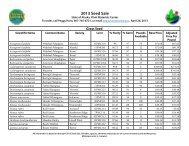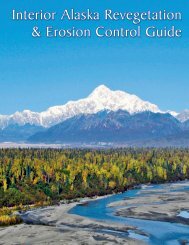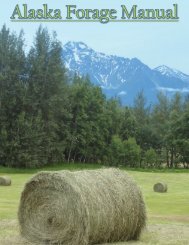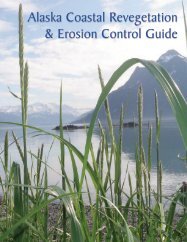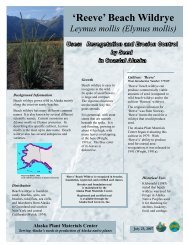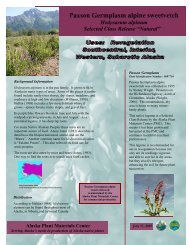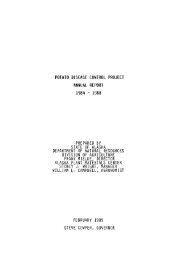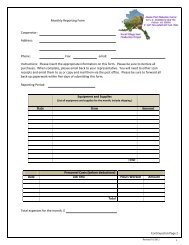Alaska Forage Manual - Alaska Plant Materials Center - State of ...
Alaska Forage Manual - Alaska Plant Materials Center - State of ...
Alaska Forage Manual - Alaska Plant Materials Center - State of ...
You also want an ePaper? Increase the reach of your titles
YUMPU automatically turns print PDFs into web optimized ePapers that Google loves.
<strong>Plant</strong>ing Choice<br />
Seed<br />
Seeding is the most common technique for establishing<br />
herbaceous plants for forage and hay. Seed<br />
is readily available for many species, and is relatively<br />
easy and inexpensive to produce. Furthermore,<br />
seed is easy to collect, process, handle, and apply to<br />
a pasture by drill or broadcast methods.<br />
The objective <strong>of</strong> seeding is to place the seed where<br />
it is needed and in proper contact with the soil. The<br />
method and equipment used depend upon the plant<br />
species being seeded and the characteristics <strong>of</strong> the<br />
site, such as soil type and topography.<br />
Only drill seeding and broadcast seeding are discussed<br />
in this manual, as these are the two most<br />
commonly used methods for establishing forage<br />
crops.<br />
‘<br />
Causes <strong>of</strong> Seeding Failure<br />
<strong>Forage</strong> seeding can involve considerable uncertainty.<br />
An awareness <strong>of</strong> limiting factors pertaining to<br />
seeding is valuable, and can help to limit uncertainty.<br />
There are many planting details that should be understood<br />
to establish forage<br />
species for pasture, hay or silage<br />
purposes.<br />
A few reasons for seeding failure<br />
include seeding too early<br />
or too late in the season, poor<br />
seedbed preparation, low<br />
quality seed, or inadequate<br />
depth <strong>of</strong> seeding. Seeding too<br />
deep is a common mistake,<br />
and seeding depth should be<br />
closely monitored.<br />
A definitive seeding plan<br />
which addresses each <strong>of</strong> the<br />
considerations listed above is<br />
<strong>of</strong>ten the best guarantee <strong>of</strong> a<br />
successful seeding result.<br />
<strong>Plant</strong>ing Method<br />
Drill Seeding<br />
Drill seeding is the most widely used method for<br />
forage plantings. When drill seeding, furrows are<br />
created and the seed is placed in the soil furrow at<br />
a controlled depth and covered with a relatively precise<br />
amount <strong>of</strong> soil. Drill seeders are used most <strong>of</strong>ten<br />
in agricultural settings. The drill seeding method<br />
is considered by many to be the best method <strong>of</strong> distributing<br />
seed. It is an effective means for establishing<br />
a high yield stand, using a smaller amount <strong>of</strong> seed<br />
compared to the broadcast method.<br />
One type <strong>of</strong> drill seeder, the Brillion style, is <strong>of</strong>ten<br />
used for planting forage. This seeder has been successfully<br />
used on most soil types, except very gravelly<br />
soils. The Brillion seeder delivers the seed into the<br />
soil, packs the seed in place, and applies seed with<br />
high accuracy.<br />
Photo: Brennan Veith Low, AK PMC<br />
22<br />
A drill seeder is towed behind a tractor at the <strong>Alaska</strong> PMC



